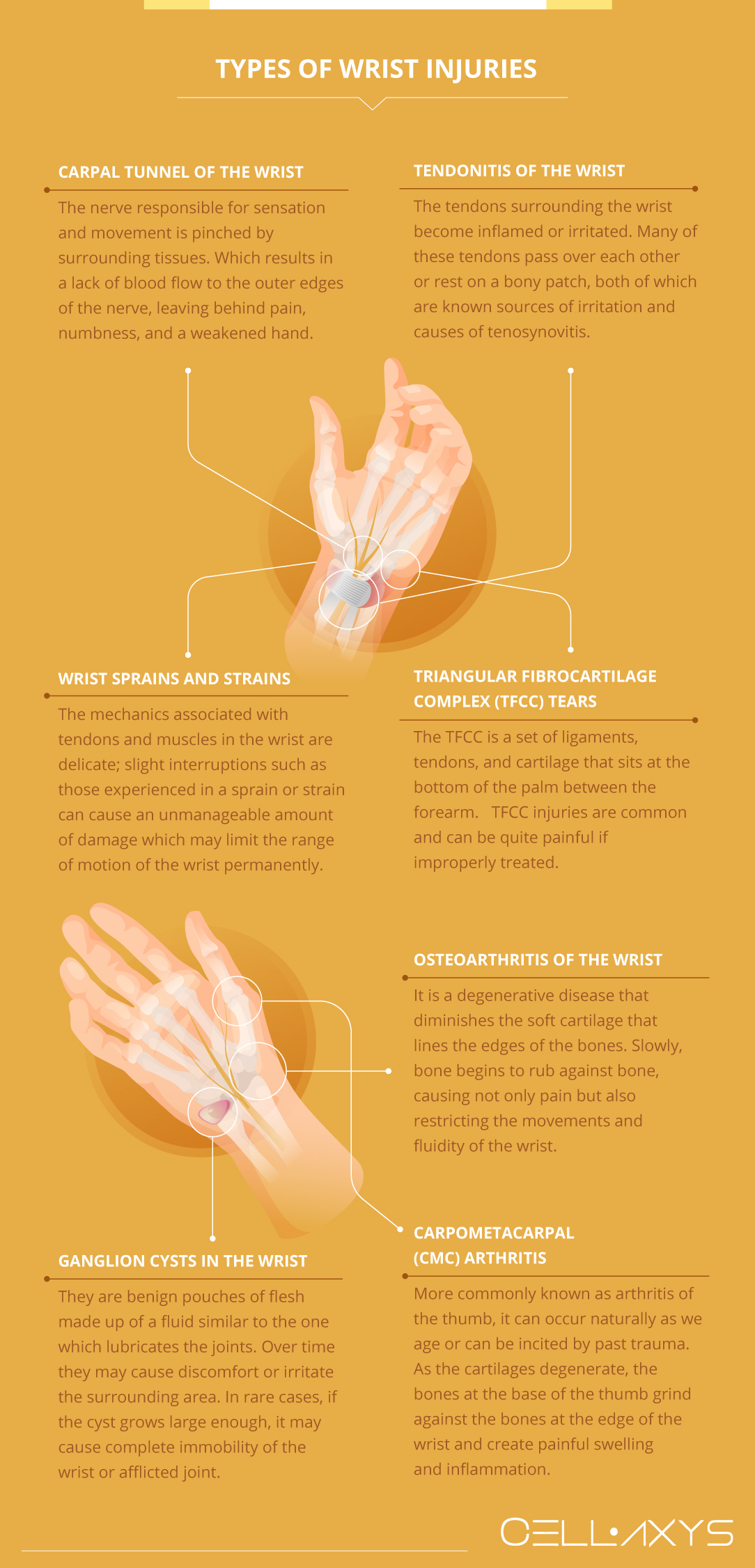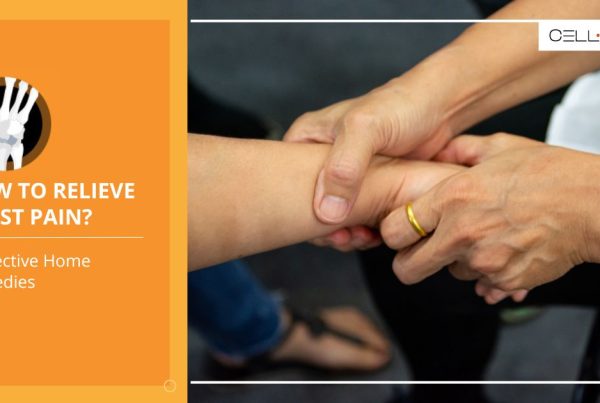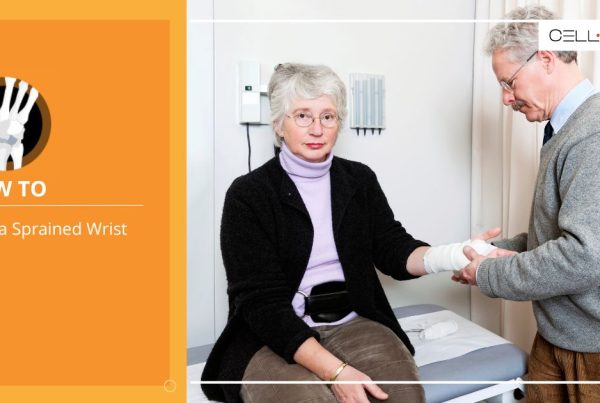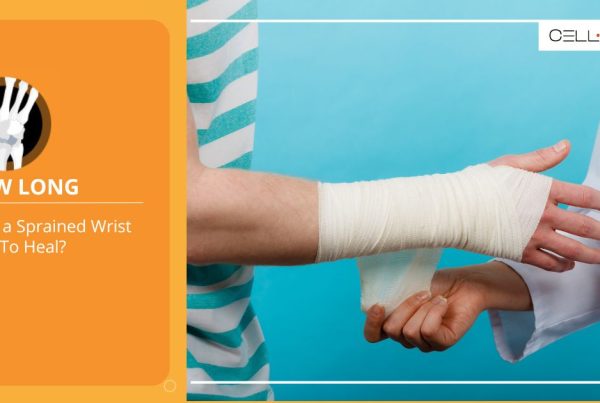Published on: June 11, 2019 | Updated on: August 29, 2024
The wrist is a complex network of small joints, tendons, ligaments, bones, and muscles that work together to provide fluid motion to the hand. These movements begin at the forearm where two of the longest bones in our bodies connect to a series of much smaller “carpal” bones near the base of the palm.
Where the two groups meet, they are woven together by a set of intricately connected ligaments. Between these bones and their connective ligaments lies a set of muscle tissues and tendons that provide the contractions necessary to move the wrist.
Types of Wrist Injuries

With so many moving parts, it’s easy to see why the wrist has an especially long list of possible complications.
There are many types of disorders and injuries related to the wrist and its many parts. Some of the most common types of wrist injuries are:
- Carpal tunnel
- Tendonitis
- Sprains and strains
- Triangular fibrocartilage complex (TFCC) tear
- Osteoarthritis
- Ganglion cysts
- Carpometacarpal (CMC) arthritis
Carpal tunnel of the wrist
Typically associated with a “tingling” sensation or sweltering pain, carpal tunnel of the wrist occurs when the nerve responsible for sensation and movement is pinched by surrounding tissues.
This pinching results in a lack of blood flow to the outer edges of the nerve, leaving behind pain, numbness, and a weakened hand.
There is not a single probable cause for carpal tunnel of the wrist, but many smaller issues likely culminate to create the pinched nerve. Swelling, inflammation, previous injuries, and repetitive motion have been shown to exacerbate the issue.
Tendonitis of the wrist
Tendonitis of the wrist, commonly referred to as tenosynovitis, occurs when the tendons surrounding the wrist become inflamed or irritated.
As these tendons continue to be irritated through daily use, the discomfort only grows larger and larger. The wrist is especially susceptible to tendonitis as it houses many small tendons which are used in repetitive motion throughout the day.
Many of these tendons pass over each other or rest on a bony patch, both of which are known sources of irritation and causes of tenosynovitis. Unfortunately, once these early symptoms set in, they seldom go away.
Wrist sprains and strains
The muscles and tendons in the wrist are much more fragile than many of those found around the body. When sprains and strains occur around the wrist, much more care is needed to fully recover.
If the injury isn’t managed properly it can lead to much more discomfort further down the road.
The mechanics associated with tendons and muscles in the wrist are delicate; slight interruptions such as those experienced in a sprain or strain can cause an unmanageable amount of damage which may limit the range of motion of the wrist permanently.
Triangular fibrocartilage complex (TFCC) tears
The wrist is a general term for a set of complex networks of small tissues which work together to provide movement to the hand. One of the most intricate of these networks is called the “triangular fibrocartilage complex” and sustaining an injury or tear to this area can wreak havoc on the natural dynamics of the wrist.
The TFCC is a set of ligaments, tendons, and cartilage that sits at the bottom of the palm between the forearm. These tissues provide cushioning and stability to rotational movements of the wrist and help the hand maintain a strong grip.
With so many small moving parts, TFCC injuries are common and can be quite painful if improperly treated. There are many stem cell and PRP regimens that may help decrease the inflammation and pain caused by a TFCC tear.
Osteoarthritis of the wrist
Osteoarthritis is the most common type of arthritis. It is a degenerative disease that diminishes the soft cartilage that lines the edges of the bones.
As the cushioning tissue which covers the bones in the wrist gradually wears away, pain and discomfort begin to emerge. The problems caused by osteoarthritis only get worse with extended use of the wrist. Slowly, bone begins to rub against bone, causing not only pain but also restricting the movements and fluidity of the wrist.
Over time, most sufferers are limited to wearing braces or taking life-altering pain medication to deal with the issues osteoarthritis of the wrist causes.
Ganglion cysts in the wrist
Ganglion cysts are benign pouches of flesh made up of a fluid similar to the one which lubricates the joints. These noncancerous growths can spring out of any joint but are most commonly found near the wrist.
While they may not seem problematic at first, over time ganglion cysts on the wrist may cause discomfort or irritate the surrounding area. In rare cases, if the cyst grows large enough, it may cause complete immobility of the wrist or afflicted joint.
Ganglion cysts are treated via surgical intervention, injections to drain the fluid, or are just left to go away on their own.
Carpometacarpal (CMC) arthritis
More commonly known as arthritis of the thumb, carpometacarpal (CMC) arthritis can occur naturally as we age or can be incited by past trauma.
Just as with osteoarthritis of the wrist, CMC pain emerges as the cushioning tissues around the base of the thumb wear away. As the cartilages degenerate, the bones at the base of the thumb grind against the bones at the edge of the wrist and create painful swelling and inflammation.
To make matters worse, CMC arthritis has been known to cause bones spurs (fractals of bone growth) which can cause pain as they stab the surrounding muscle tissues.
Autologous stem cell therapies can help alleviate some of the pain caused by the lack of cartilage while also providing a suitable environment for our bodies to regenerate any damaged tissue.
Regenerative Therapy
Though many of these wrist complications are untreatable, most of them are medically manageable through regenerative therapy. With recent advancements in orthobiologic treatments, including cell-based and platelet-rich plasma (PRP) therapies, many of the symptoms and pains of wrists can now be treated.
These orthobiologic treatments are performed in a short time span. They are non-invasive and less painful than surgical methods and are outpatient procedures, which means you can go home after the treatment.
Cell-Based Therapies
Cell-based therapies, or stem cell therapies, focus on replacing the damaged tissues from the injury site with healthy ones. The new cells or tissues come from the patient, also called “autologous tissues.”
Depending on the situation of your wrist, your doctor will recommend one of the two types of cell-based therapies:
- Minimally Manipulated Adipose Tissue (MMAT) transplant. MMAT is super effective in many injuries. The procedure includes harvesting healthy cells from your adipose tissues and re-injecting them into the wrist. MMAT can be performed in multiple locations in the same procedure.
- Bone Marrow Concentrate (BMAC). This method extracts healthy cells from your bone marrow, particularly the highly concentrated ones, and reinjects them into the injury site for a speedy recovery.
Cell-based therapies are performed within 1.5 to 2 hours. During the procedure, you will be under anesthesia. The doctor will use an X-ray or ultrasound to locate the right injury spots in your wrist.
Platelet-Rich Plasma (PRP) Therapy
PRP therapies isolate healing components from your blood plasma called platelets. These platelets are then processed and concentrated before reinjecting them into the patient’s injury site. Platelets perform three critical functions in your body.
They release 10 Growth Factors that stimulate the growth of healthy tissue development. These essential elements also send chemical signals to attract growth cells in your blood and produce fibrin. It is a web-like structure that supports the growth of new, healthy tissues.
PRP aims to insert platelets in your injured area to promote healing. The process takes about 45 minutes to complete.
Cellaxys offers comprehensive treatment methods for all of the above-listed illnesses and many others associated with wrist pain. Contact one of our specialists today for more information.
Sources
Footnotes
- Parmelee-Peters K, Eathorne SW. The wrist: common injuries and management. Primary Care: Clinics in Office Practice. 2005;32(1):35-70.
- Pulos N, Kakar S. Hand and wrist injuries: common problems and solutions. Clinics in sports medicine. 2018;37(2):217-43.
- Rettig AC. Epidemiology of hand and wrist injuries in sports. Clinics in sports medicine. 1998;17(3):401-6.
- Garcia-Elias M, Folgar MÁ. The management of wrist injuries: An international perspective. Injury. 2006;37(11):1049-56.
- Kawamura K, Chung KC. Management of wrist injuries. Plastic and reconstructive surgery. 2007;120(5):73e-89e.
References
- Wrist Injuries and Disorders. MedlinePlus. Accessed 2/25/2024.
- Common Conditions of the Wrist: A Powerful but Vulnerable Joint. HSS. Accessed 2/25/2024.
- Hand and Wrist Sports Injuries. Physiopedia. Accessed 2/25/2024.
- Tenosynovitis. Medscape. Accessed 2/25/2024.
CELLAXYS does not offer Stem Cell Therapy as a cure for any medical condition. No statements or treatments presented by Cellaxys have been evaluated or approved by the Food and Drug Administration (FDA). This site contains no medical advice. All statements and opinions are provided for educational and informational purposes only.
Dr Pejman Bady
Author
Dr. Pejman Bady began his career over 20 years ago in Family/Emergency Medicine, working in fast-paced emergency departments in Nevada and Kansas. He has served the people of Las Vegas as a physician for over two decades. Throughout this time, he has been met with much acclaim and is now the head of Emergency Medical Services in Nye County, Nevada. More about the doctor on this page.
Dr Pouya Mohajer
Contributor
Pouya Mohajer, M.D. is the Director of Spine and Interventional Medicine for CELLAXYS: Age, Regenerative, and Interventional Medicine Centers. He has over 20 years of experience in pain management, perioperative medicine, and anesthesiology. Dr. Mohajer founded and is the Medical Director of Southern Nevada Pain Specialists and PRIMMED Clinics. He has dedicated his career to surgical innovation and scientific advancement. More about the doctor on this page.









